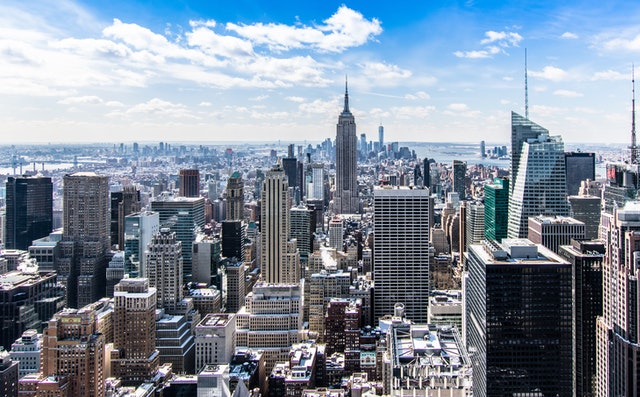I just got back from a rather quick work-oriented visit to New York City, with a bit of money left in my pocket. I’d been trying to control the hemorrhaging of cash that always happens in the Big Apple. I mean, everything just costs more there. In the course of my research for the presentation I gave there, I’d been doing a survey of apartment prices in Manhattan, and I was nearly overcomeWho is renting all those $3,000/month one-bedrooms? Looking for a souvenir for the kids, I took a stroll down 57th Street, idly wondering how much of my annual income I’d spend, if I just blithely went Christmas-shopping down this street. From a Waldo County perspective, New York City is simply a whole nother economy. How could my family possibly live here, on what we make? And yet: guess what? The median income of an apartment-renter in New York City is about $32K, which is a tad less than what we live on up here in Jackson.
Making a living in New York is a very competitive thing: I walked past a bodega on the West Side that advertised its being “OPEN 25 HOURS”.
On the way out of New York I had a surprisingly pleasant pre-trip breakfast at Port Authority. It was served by a young Asian man — Chinese, I think, or possibly Korean (I imagine he thought I looked English, or possibly French). He made sandwiches diligently and well, his prices were OK, and his demeanor was very pleasant. He seemed to appreciate my mentioning this to him, and he told me that, because of a friend’s birthday party, he’d had only had half an hour’s sleep the night before. Compared what I had come to expect from dining at the Port Authority, this was absurdly pleasant, almost like getting an unexpected check from the IRS.
The breakfast I had expected would’ve been served in a place such as that pretentious franchise bakery place, “The Pain”, by a spectacularly surly young black woman whose main purpose evidently is to let me know how much of an imposition it is to get me a breakfast sandwich, and how cruelly she is being exploited by those who pay her ridiculously low wages to stand there and do it.
Believe me, dear reader, I recognize the need for caution here. I seem to be making an egregiously racist — not to mention sexist — statement, and I can only plead the evidence that I have been served breakfast by quite a few young women who fit that description. If such employees are now being replaced at the Bus Terminal by a more polite corps with different ethnic backgrounds, it will undoubtedly be seen — and probably rightly — as just one more case of African-Americans in the US economy: last hired, first fired, and treated like dirt.
Yet the young Asian man wasn’t being treated any better — certainly not in the sense that he represents a particular class of employee. There’s a mystery here. I did not blame those black women — I sure don’t want their jobs — but I can’t deny that they clearly and openly disdained the job they were doing, and made a sort of political street-theater out of doing it. If workers from another place, or perhaps another cultural tradition, are willing to just do the job — rather than make a statement out of just-barely doing it — it’s not hard to see why those employers wouldn’t prefer them.
Yes, I hear those cautionary bells again! Could I actually be suggesting that these “shiftless” African-Americans lack — just congenitally, racially lack — the industrious discipline of each immigrant group that has marched past them on the socioeconomic ladder? Well, if I were saying that, I wouldn’t be the first. Yet that “explanation” explains nothing, and it is belied by a great wealth of evidence from the history of Black Americans.
Somewhere amid my taking a subway to the bus station (rather than, you might say, taking a limo to the airport), a possible explanation started to dawn on me. Yes, I thought, the cost of living in Waldo County, Maine does seem like another world compared to New York — but Waldo County is still (marginally, anyway) ensconced in the First World. How unimaginably different is New York’s economy from that known to the immigrant from China, or Santo Domingo, or Pakistan? In a very real sense, those low-wage immigrant workers (on which New York’s economy greatly depends) are earning their wages in one economy, and spending them in another. Many of them are working sub-minimum-wage jobs, living packed in tiny apartments, and yet sending home American currency that provides significant help to their families elsewhere.
None of that is so for New York’s African-American workers. They don’t have another economy to spend their money in. They have been right here all along, renting their apartments from American landlords and paying ghetto-premium prices for goods they buy in local stores. The value of their savings doesn’t multiply when they pass it on to their families — as it would if the families lived in Senegal. They have to spend it here, knowing they’re being ripped off, both as workers and as consumers. Seems to me that’s more than enough to explain the resentment.
Perhaps this intersecting of economies is a key, on many levels, to the meaning of globalization. Undoubtedly it’s what underlies the claims made by business-friendly analysts that trade liberalization and privatization have increased living standards everywhere they have reached. In a sense, of course, they have — the numbers these economists point to are real numbers. Yet, if that were all there is to it, why would globalization stir up such bitter resistance?
One might object that economies have been intersecting for centuries. But for the most part that was a matter of ships bringing exotic goods from faraway lands — as in the days when “imported” products were finer, more top-shelf (imported discount-store items still sometimes try, rather pathetically, to affect this). This “old-style” international trade didn’t entail a lot of cultural interaction or competition. Nowadays it seems that more and more of the economic intersection is happening in the same place, at the same time — and that, I am beginning to suspect, is the source of a great deal of today’s weirdness.
It might be worthwhile to draw a sort of Venn diagram of these economic communities that are being pulled together by the global economy, and to compare them to the different, but related circles of intersecting culture and language.
A familiar way of one economy intersecting with another is by completely subsuming it (probably in the hope of showing it the door), allowing it no place but the shadows. I thought of that recently in Austin, Texas. Now, I realize I shouldn’t single Austin out in this way; Austin is a growing, pleasant city with a lot going for it. But like every growing city in the US today, it is sprawling, sprawling, sprawling. A huge, sweeping system of new expressways is still under construction there (so new, in fact, that the MapQuest directions to our hotel were utterly useless). Hearing from the desk clerk that a pancake restaurant was “right across the street”, we piled into our rental-car and proceeded to drive about five miles, discovering on the way a novel traffic-management item: the U-turn-only lane. (Most of us think of a U-turn as a way to rectify a mistake.) Now, amid many of these vast, malignant cloverleaf-blooms were panhandlers standing out in the Texas sun. Not so surprising, I guess, yet I did find it a bit disturbing that there was a thriving financial-service business in Austin offering “payday loans” — could there be a more efficient engine of downward mobility? Amid all this highway construction, we looked and looked until we actually saw, at last, a public bus. It could not be doubted that the folks who use public transportation in Austin are also the ones who take out the payday-loans, or failing that, work the medians, with squeegees, or cardboard signs narrating their misfortune. It may be stretching things to call this group, class, or ilk of people “an economy” — yet I think it fits, because after all, they are surviving, somehow — and most of the food, clothing and shelter they’re managing to get is coming from “informal”, “sub-marginal” economic processes. The boom-town of Austin, with Dell Computer, the University of Texas and a happening music scene, would wish to intersect with this underclass “economy” as little as possible — though it does, at least, provide it with bus service.
Or, two economies could intersect along a dynamic and fascinating edge-region — think of the Venn diagram again — as in, say, how the US economy intersects with India’s. There are overall effects, on the large circles of each nation, that have the familiar character of international trade, flows of goods and credit and whatnot. But there is also, in that region of intersection, a place that is neither, yet both. Perhaps that region is where globalization is really happening. On one edge are the waiters, taxi drivers or newsstand clerks who do the jobs that “we” don’t want because the paltry wage they earn is, nevertheless, a significant income for their purposes. One the other leading edge are the software engineers or telephone-service operatives who are snapping up “our” jobs at much higher rates of productivity. Economists identify both cases as the Invisible Hand picking away at the levee of protection and subsidy; the flood of profit-maximizing efficiency is bound to come.
Another kind of troubling frontier is the sort where a “traditional economy” — West African peasants, say, who retain a large measure of their traditional land-tenure patterns — meets the demands of modernization in the name of “structural adjustment” (or whatever). Hernando de Soto, in the noted book The Mystery of Capital, sees this as a great blessing, a key to near-utopian levels of global prosperity. Others swear it is a curse and a sham. It can take the form of the millions of tiny business loans, savings accounts and insurance policies that have begun forming in many poor countries (which could provide capital, for example, for a Bangladeshi farmer to acquire a treadle pump, enabling his family to triple the output of their tiny farm). Or, it could take the form of the statistics that purport to show how much the tiny wages of displaced peasants living in urban shantytowns have “increased” their nation’s GDP, thus entitling it to consideration for possible debt relief.
Free-market enthusiasts, who argue that our world needs much more globalization, see the displacement and suffering brought about in these dynamic border-zones as well worth the cost of the overall efficiency and prosperity that they engender. But Green and left-wing critics of globalization look into these border zones and see nothing but degradation and exploitation. Neither extreme is useful or sensible. No, no, let’s not have globalization; it leads us to bad places, and while we’re at it let’s have no long-distance communication, no labor-saving machines and no education — just look where all these things have led us!
Yet this past weekend it started to dawn on me (at long last) that the transition-zones between intersecting economies are really where the action is. People are going to move forward; they are going to communicate and trade; they are hard-wired to do so and the only way to stop them from doing it is to kill them. And while we’re restating obvious facts, let’s remember this one: every advance in efficiency, every material step forward, increases the un-earned market power of those we allow to “own” the Earth’s natural opportunities.



